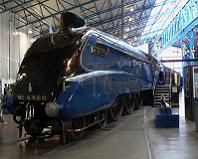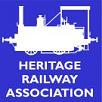THE ASIAN NETWORK OF INDUSTRIAL HERITAGE BULLETIN
|
30th June 2019: Heritage Rail in the United Kingdom and Ireland
In the “The Asian Network of Industrial Heritage” Bulletin I submitted a piece on the Heritage Rail in the United Kingdom and Ireland. Railways all over the world can trace their origins back to the UK at the beginning of the 19th century. When Richard Trevithick built the first steam powered railway locomotive in 1804, it carried 10 tons of iron almost 16 km in just over four hours. With proof that steam traction was viable, the UK built a railway network that grew at its peak to almost 38,000 km of rail by the beginning of the 20th century. Under UK Government ownership in the 1960s, the railways faced increasing competition from car ownership and road use. In a misguided attempt to save money, the government closed almost 10,000 km of line and over 2,300 stations. At the same time, the rise of diesel and electric traction saw Britain’s last publicly operated steam service in 1968. Those changes provided Britain’s emerging heritage rail industry with the impetus and the potential to play what is today a very significant part in Britain’s leisure and tourism economy – and more. Closed lines, scrap locomotives and rolling stock provided the raw materials for a growing number of heritage-minded enthusiasts. Image Caption: The Ffestiniog Railway is the world's oldest narrow gauge railway with almost 200 years of history. Now a major tourist attraction in North Wales, it takes passengers on a 22 km journey from the harbour in Porthmadog to the slate-quarrying town of Blaenau Ffestiniog. From small starts to big business Heritage railways in the UK and Ireland now operate some 600 route miles. They attract around 13 million visitors every year, and carry them over 130 million passenger miles. Around 4000 people are employed full-time in the sector, supported by some 22,000 volunteers. The economic benefits of their railways and tramways spill over into their wider communities, with research suggesting local economies benefit by almost three times the railway or tramway’s turnover. That in turn suggest that heritage rail is worth as much as £400 million to the UK economy. The richness and scale of the UK’s heritage rail draw visitors not just from at home, but from all corners of the world. Rail enthusiasts, of course, have their own agendas and itineraries, but the location and nature of many railways also appeals strongly to ordinary visitors to the UK. Heritage rail’s full contribution to Britain’s inbound tourism economy is, of course, difficult to measure. But there’s no doubt in any quarter that the contribution is as significant as many of the UK’s other international attractions – such as Buckingham Palace, The Tower of London, Edinburgh Castle and many others - put together. Image Caption: Caption: The North Yorkshire Moors Railway is a preserved historic railway stretching for 18 miles through the heart of the North York Moors National Park, from Pickering to Grosmont, with a 10 km extension over Network Rail’s Esk Valley line to Whitby. It is the largest preserved heritage railway in the UK in terms of route mileage operated and passenger numbers. Also known as Yorkshire’s Magnificent Railway it is locally, regionally and nationally significant due to its historic, scientific, aesthetic, cultural and social values. Heritage rail travel in the UK is not limited to the sector’s own track. The country’s main line network owners understand the historic and commercial benefits of steam hauled trains, carrying passengers in heritage carriages, on substantial journeys across some of the country’s most spectacular scenery. Other heritage railways provide public transport services, or tourist transport, especially in destinations where car-free access is a benefit. A national asset The value of heritage rail in the UK is more than simply commercial. There is a widespread understanding at every level that Britain’s railways enabled much of the nation’s industrial, economic and social development. Heritage railways are important and highly-valued elements of living history, which merit the same safeguarding that applies to historic buildings, landscapes and institutions. Locomotives such as Flying Scotsman and Mallard are internationally recognised icons of British history and engineering (with Flying Scotsman happily restored, and working regularly on Britain’s main lines and heritage railways). They, with tramways and museums, do a vital job in informing and in educating, just as much as they do in providing leisure and entertainment. Britain’s heritage railways also provide valuable skills training. Often, they do this in areas where employment opportunities, particularly for skilled workers, are low. In particular, they provide entry level jobs for a wide range of skills and disciplines. For younger staff and volunteers, they offer a valuable training ground for subsequent jobs on the main line network or elsewhere. Those of us involved in railway heritage have a duty to ensure that what is important to Britain’s railway history is preserved and made available for present and future generations to enjoy. We do this in a variety of ways. The first is to maintain world class railway museums which tell the complete railway story, from their effect on social, business and industrial life through to demonstrating the very latest developments in modern railway operations. The National Railway Museum at York – part of the Science Museum Group – is the very best example, and maintains the proud tradition of free entry (none of Britain’s national museums and galleries charge for admission). The structure and ownership of Britain’s railways have undergone many changes since their earliest days - from tiny private companies in the 1840s to the creation of the “big four” railway groupings in 1923, state ownership from 1948 to 1995, and private ownership of the train operating companies from then up to the present day. To keep track with all the changes, and to make sure that precious artefacts and records were not lost with privatisation, our parliament passed the Railway Heritage Act in 1996 which gave them legal protection. I have had the privilege of being involved with this process since 2002, for much of the time chairing the committee or board responsible. I believe Britain is the only country in the world that has passed legislation specifically to ensure that we secure the preservation of evidence which is significant to the railway’s history. Rail is the only industry in the UK which is viewed in this way. Enshrined in the legislation which privatised Britain’s railways in the 1990s are a series of requirements about the treatment of railway items of historical interest. In the days when we had one large state industry, life was simpler. Britain’s national record offices and the National Railway Museum could readily judge what they considered important for their collections; and simply request the British Railways Board to hand items over once they were no longer needed. Image Caption: The Gloucestershire Warwickshire Steam Railways runs along the Gloucestershire and Worcestershire border of the England’s Cotswolds Hills. The GWSR has restored and reopened around 23 km of track, operating between Cheltenham Racecourse and Broadway. The 45 km round trip on steam and heritage diesel trains follows part of the route of the former Great Western main line from Birmingham to Cheltenham. But that approach could not work with the privatised network. For one thing, The National Archives has no remit other than in special circumstances – to take the records of private companies. A new approach was needed. The solution lay originally in the creation of a new statutory body called the Railway Heritage Committee. The Committee was given the legal power to ‘designate’ – and subsequently agree the disposal of – significant railway records and artefacts that justified long-term preservation, which since 2005 have included the military railways owned by the Ministry of Defence. The range of items and records designated – and thus saved from unauthorised sale or scrapping – is enormous. There are well over a thousand artefacts protected in this way. Effective support Perhaps surprisingly, heritage rail in the UK is unsubsidised. Other than modest grants (for which bidding is often competitive), the industry pays its own way. It benefits from the support of the UK Parliament’s All-Party Parliamentary Group on Heritage Rail (which I help to found in 2011). The group is effective in briefing parliamentarians about heritage railways, the contribution they make to their local and national economies, and the skills training oppor - tunities it provides. In a world complicated by standards and legislation designed for a national railway, the APPG on Heritage Rail gives the sector a much needed voice at government level. On a day-to-day level, the interests of Britain and Ireland’s heritage railways are served and promoted by the Heritage Railway Association (HRA). A volunteer-run trade association, it represents and supports over 180 member organisations. The HRA provides a steady stream of news, guidance and advice on every aspect of running a heritage railway. It maintains a busy programme of seminars and events, and liaises with similar organisations across the world. The HRA also administers the very successful Inter- Rail Card scheme. Holders of the modestly-priced card are entitled to privilege rates, discounts or free travel on over 100 HRA member railways. A positive future National and European environmental legislation is curtailing the use of coal for energy. There is adequate availability of coal for the heritage rail sector – it uses a very small fraction of the amount of coal traditionally used for power generation or domestic heat. However, the industry is working to reassure both government and environmental lobbies that steam-hauled railways play their own part in ‘green tourism’. Those many million steam-hauled passenger miles represent dramatically fewer emissions than would be generated if those passenger miles were undertaken by car or even coach. And many of those passenger miles travel through sensitive natural landscapes where heavy road use would be considered harmful. In recent times, a weakening of the value of the British Pound has made a visit to the UK more attractive, leading to an increase in visitors from overseas. For the same reason, a greater number of UK residents have stayed at home for their vacations. The effect is visible in heritage rail, with visitor numbers continuing to increase. Awareness of heritage rail in the UK goes on growing, as do the standards of railway restoration, presentation and operation. Heritage rail, with all its visual attractions and dynamic properties, also appeals to producers of film companies and TV shows. The income from a film and TV production can generate useful income for a railway. In addition, promotion of heritage rail in national TV programmes and cinemas can be a powerful benefit – think of the Harry Potter movies and Hogwart’s Express. Such new opportunities increase understanding and recognition of UK heritage rail as a sector with enduring appeal for young and old, enthusiasts and families. Please come to Britain and enjoy these wonders for yourselves! Image Caption: The most recent extension to Broadway involved raising £1.38 million. Platforms, new buildings and a bridge, built by volunteers. Download and read the full bulletin here here |






































